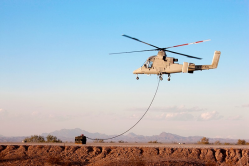FLIGHT OF THE DRONES
PHOTO // Courtesy of LOCKHEED MARTIN, SCHIEBEL and DRAGANFLY INNOVATIONS
A new breed of autonomous vehicles - helicopter drones - is beginning to make their mark in the UAV (Unmanned Aerial Vehicle) scene.
Developed for a wide spectrum of operations, from surveillance and reconnaissance to combat support, helicopter drones in the military have been so successful that they have even been considered for use in other areas.
For instance, broadcast news stations in the United States (US) have started to discuss the possible use of military-grade drones to record and broadcast breaking events without risking the lives of journalists.
Unlike most conventional unmanned systems which still require operators to control them using radio signals, these drones can execute missions based on pre-set waypoints.
Their advantage lies in their vertical take-off and landing (VTOL) system, which eliminates the need for runway access that is essential to airplane drones.
Here are two of the latest models that are currently on trial.
A Kaman K-MAX UAT delivering its cargo to the targeted location.
Timely, accurate delivery
The Kaman K-MAX Unmanned Aerial Truck (UAT) is a helicopter drone designed for cargo transportation and delivery.
With a high payload of up to 2,720kg, the K-MAX is also equipped with a multi-hook carousel that enables it to release loads at four separate destinations autonomously and precisely in a single mission.
The drone also utilises a synchronised twin-rotor system, with two side-by-side pylons mounted at a slight angle on the helicopter's roof supporting counter-rotating blades. This gives the helicopter exceptional stability while hovering, allowing for pinpoint cargo delivery and eliminating the need for a tail rotor.
As a result, the K-MAX is able to provide precision delivery of cargo, such as food, medical supplies and ammunition, to inaccessible territories like disaster-hit areas where roads and transport infrastructure have been destroyed.
The drone can also aid surveillance operations as it is able to insert and retrieve unmanned ground vehicles, and place data relay stations or communication equipment without endangering the lives of crew.
From January 2012, the drone was used by the US Marines from UAV Squadron One for transport missions to deliver food supplies and spare parts to forward operating bases as well as remote places in Afghanistan.
These drones are used to replace strategic convoys as the latter are especially vulnerable to ambush and dangers such as improvised explosive devices, thus reducing the number of casualties.
| TECH SPECS (Kaman K-MAX UAT) |
|---|
| Dimensions 15.85m (length) x 3.80m (width) x 4.10m (height) |
| Rotor diameter 14.7m |
| Maximum take-off weight 3,175kg |
| Maximum payload 2,720kg |
| Maximum cruise speed 148kmh |
| Endurance 12 hours |
| Range 1,850km |
The Camcopter S-100, which sports state-of-the-art sensor systems, is used primarily for surveillance.
Enhanced surveillance
Developed by Schiebel, the Camcopter S-100 is an unmanned rotorcraft system used for surveillance and reconnaissance purposes.
As a standard, this helicopter drone is equipped with the Stabilised Day and Night Electro Optical/Infrared cameras, but it can be configured to carry other compatible sensors, such as the Synthetic Aperture Radar. The camera produces accurately-coloured images based on electromagnetic energy reflected or absorbed by objects, just like a normal camera.
On the other hand, the equipped radar utilises the long-range propagation characteristics of radar signals to generate high-resolution images (usually in black-and-white) of the landscape below, thus providing terrain information to the users.
It can also identify and recognise selected man-made targets, and can even be used under harsh weather conditions, thus augmenting its surveillance and reconnaissance capabilities.
In addition to its sensor imagery systems, the Camcopter provides a real-time video picture, enabling the crew to see conflicting traffic or any obstacles that may be present.
The encrypted data will then be sent to the ground control station, where operators will have access to mission planning information, video-viewing, recording and frame capture features. This allows them to process the information and make appropriate decisions.
To date, the Camcopter has been purchased by several militaries across the globe, such as the Union Defence Force of the United Arab Emirates, which was the launch customer of the machine, and the military forces of China and Jordan. It has also attracted interest from the German, French, Pakistani and the Australian armed forces.
| TECH SPECS (Camcopter S-100) |
|---|
| Dimensions 3.11m (length) x 1.24m (width) x 1.12m (height) |
| Rotor diameter 3.4m |
| Maximum take-off weight 200kg |
| Maximum payload 50kg |
| Maximum cruise speed 240kmh |
| Endurance 6 hours |
| Range 180km |
The Draganflyer is an example of a drone that can be used outside the military context: for police surveillance.
Rotorcraft of the future
While the use of helicopter drones has been extensive in the military, they have also been used in other areas for a wide variety of purposes, such as inspecting oil equipment, checking crops and surveying wildlife.
For instance, the Draganflyer X6 Six Rotor UAV Helicopter is being used on a trial basis by a number of US police stations to conduct surveillance.
Future rotorcraft may well come in the almost undetectable size of small insects, as nano quad-rotors which resemble bees and flies are now already in the experimental stages. More agile and manoeuvrable, they are able to execute landings with precision and fly off again at speed.
The US Army has been looking into VTOL UAVs, particularly helicopter drones, since 2011, and has been involved in several projects to introduce and deploy them. This bears testament to how invaluable helicopter drones will be in the future, especially with the impending rise of autonomous warfare.










